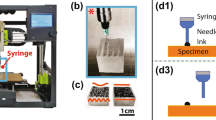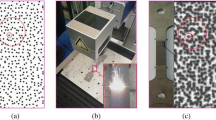Abstract
Background
Digital Image Correlation (DIC) is a length scale independent surface pattern matching and tracking algorithm capable of providing full field deformation measurements. The confident registration of this pattern within the imaging system becomes key to the derived results. Practically, conventional speckling methods use non-reliable, non-repeatable patterning methodologies including spray paints and air brushing leading to increased systematic and random errors based on the user’s experience.
Objective
A methodology to develop a speckle pattern tailored to the imaging and experimental conditions of the given system is developed in this paper.
Methods
In this context, a novel bio-inspired speckle pattern development technique is introduced, leveraging spatial imaging parameters in addition to frequency characteristics of speckle patterns, enhancing the results obtained through DIC. This novel technique leverages gradient parameters in the frequency spectrum obtained from patterns fabricated using a bio-templating manufacturing technique.
Results
The analysis presented shows that optimized gradient features alongside tailored spatial characteristics reduce errors while increasing the usefulness of DIC results across the entire region of interest. With this new approach, gradient information is derived from the bio-templated pattern, extracted, optimized and then convolved with spatial properties of a numerically generated 2D point clouds which can then be transferred onto actual specimens. Numerical error analysis shows that the optimized patterns result in significant reduction in root mean square error compared to conventional speckling methods.
Conclusions
Physical experiments show the scalability of this optimized pattern to allow for varying working distances while consistently maintaining a lower error threshold compared to conventional speckling techniques.












Similar content being viewed by others
References
Peters W, Ranson W (1982) Digital imaging techniques in experimental stress analysis. OPTICE 21(3):213427
Sutton M, Wolters W, Peters W, Ranson W, McNeill S (1983) Determination of displacements using an improved digital correlation method. Image Vis Comput 1(3):133–139
Sutton M, Mingqi C, Peters W, Chao Y, McNeill S (1986) Application of an optimized digital correlation method to planar deformation analysis. Image Vis Comput 4(3):143–150
Sutton MA, McNeill SR, Jang J, Babai M (1988) Effects of subpixel image restoration on digital correlation error estimates. OPTICE 27(10):271070
Peters W, Sutton M, Ranson W, Poplin W, Walker D (1989) Whole-field experimental displacement analysis of composite cylinders. Exp Mech 29(1):58–62
Sutton M, Turner J, Chao Y, Bruck H, Chae T (1992) Experimental investigations of three-dimensional effects near a crack tip using computer vision. Int J Fract 53(3):201–228
Olson LE, Abrego A, Barrows DA, Burner AW (2010). Blade deflection measurements of a full-scale UH-60A rotor system
LeBlanc B, Niezrecki C, Avitabile P (2010). Structural health monitoring of helicopter hard landing using 3D digital image correlation. In: Health Monitoring of Structural and Biological Systems, 2010. International Society for Optics and Photonics, p 76501V
Caporossi P, Mazzanti P, Bozzano F (2018) Digital image correlation (DIC) analysis of the 3 December 2013 Montescaglioso landslide (Basilicata, southern Italy): results from a multi-dataset investigation. ISPRS Int J Geo Inf 7(9):372
Sutton M, Ke X, Lessner S, Goldbach M, Yost M, Zhao F, Schreier H (2008) Strain field measurements on mouse carotid arteries using microscopic three-dimensional digital image correlation. Journal of Biomedical Materials Research Part A: An Official Journal of The Society for Biomaterials, The Japanese Society for Biomaterials, and The Australian Society for Biomaterials and the Korean Society for Biomaterials 84(1):178–190
Eleftheroglou N, Zarouchas D, Loutas T, Alderliesten R, Benedictus R (2018) Structural health Monitoring data fusion for in-situ life prognosis of composite structures. Reliab Eng Syst Saf 178:40–54
Pan B, Qian K, Xie H, Asundi A (2009) Two-dimensional digital image correlation for in-plane displacement and strain measurement: a review. Meas Sci Technol 20(6):062001
Sutton MA, Orteu JJ, Schreier H (2009). Image correlation for shape, Motion and Deformation Measurements: Basic Concepts,Theory and Applications. Springer Publishing Company, Incorporated,
Lecompte D, Sol H, Vantomme J, Habraken A (2006) Analysis of speckle patterns for deformation measurements by DIC. Proceedings of SPIE 6341:E1–E6
Lecompte D, Smits A, Bossuyt S, Sol H, Vantomme J, Van Hemelrijck D, Habraken A (2006) Quality assessment of speckle patterns for digital image correlation. Opt Lasers Eng 44(11):1132–1145
Stoilov G, Kavardzhikov V, Pashkouleva D (2012) A comparative study of random patterns for digital image correlation. J Theor Appl Mech 42(2):55–66
Su Y, Zhang Q, Xu X, Gao Z (2016) Quality assessment of speckle patterns for DIC by consideration of both systematic errors and random errors. Opt Lasers Eng 86:132–142
Hua T, Xie H, Wang S, Hu Z, Chen P, Zhang Q (2011) Evaluation of the quality of a speckle pattern in the digital image correlation method by mean subset fluctuation. Opt Laser Technol 43(1):9–13
Pan B, Lu Z, Xie H (2010) Mean intensity gradient: an effective global parameter for quality assessment of the speckle patterns used in digital image correlation. Opt Lasers Eng 48(4):469–477
Lane C, Burguete RL (2008) Shterenlikht a an objective criterion for the selection of an optimum DIC pattern and subset size. Proceedings of the XIth International Congress and Exposition, pp 1–9
Bossuyt S (2013) Optimized patterns for digital image correlation. In: Jin H, Sciammarella C, Furlong C, Yoshida S (eds) Imaging methods for novel materials and challenging applications, Proceedings of the 2012 annual conference on experimental and applied mechanics, vol 3. Springer New York, New York, NY, pp 239–248. https://doi.org/10.1007/978-1-4614-4235-6_34
Liu X-Y, Li R-L, Zhao H-W, Cheng T-H, Cui G-J, Tan Q-C, Meng G-W (2015) Quality assessment of speckle patterns for digital image correlation by Shannon entropy. Optik-International Journal for Light and Electron Optics 126(23):4206–4211
Dong Y, Pan B (2017) A review of speckle pattern fabrication and assessment for digital image correlation. Exp Mech 57(8):1161–1181
Yaofeng S, Pang JH (2007) Study of optimal subset size in digital image correlation of speckle pattern images. Opt Lasers Eng 45(9):967–974
Dong YL, Pan BJEM (2017) A Review Of Speckle Pattern Fabrication And Assessment For Digital Image Correlation. 57(8):1161–1181. https://doi.org/10.1007/s11340-017-0283-1
Sutton M, Ke X, Lessner S, Goldbach M, Yost M, Zhao F, Schreier HJJoBMRPAAOJoTSfB (2008). The japanese society for biomaterials,, biomaterials TASf, Biomaterials tKSf Strain field measurements on mouse carotid arteries using microscopic three-dimensional digital image correlation. 84 (1):178–190
Jonnalagadda K, Chasiotis I, Yagnamurthy S, Lambros J, Pulskamp J, Polcawich R, MJEm D (2010) Experimental investigation of strain rate dependence of nanocrystalline Pt films. 50(1):25–35
Li N, Guo S, Sutton MA (2011) Recent progress in e-beam lithography for SEM patterning. In: MEMS and nanotechnology, volume 2. Springer, pp 163–166
Kammers AD, Daly SJEM (2013) Self-assembled nanoparticle surface patterning for improved digital image correlation in a scanning electron microscope. 53(8):1333–1341
Reu PL, Sweatt W, Miller T, Fleming D (2015) Camera system resolution and its influence on digital image correlation. Exp Mech 55(1):9–25. https://doi.org/10.1007/s11340-014-9886-y
Pan B, Xie H, Wang Z, Qian K, Wang Z (2008) Study on subset size selection in digital image correlation for speckle patterns. Opt Express 16(10):7037–7048
Zhou P, Goodson KE (2001) Subpixel displacement and deformation gradient measurement using digital image/speckle correlation. OPTICE 40(8):1613–1621
Schreier HW, Braasch JR, Sutton MA (2000) Systematic errors in digital image correlation caused by intensity interpolation. OPTICE 39(11):2915–2921
Mathew M, Ellenberg A, Esola S, McCarthy M, Bartoli I, Kontsos AJSC, Monitoring H (2018) Multiscale deformation measurements using multispectral optical metrology. 25(6):e2166
Wang Y, Sutton M, Bruck H, Schreier H (2009) Quantitative error assessment in pattern matching: effects of intensity pattern noise, interpolation, strain and image contrast on motion measurements. Strain 45(2):160–178
Bomarito G, Hochhalter J, Ruggles T, Cannon AJO (2017) Engineering Li, Increasing accuracy and precision of digital image correlation through pattern optimization. 91:73–85
Su Y, Gao Z, Fang Z, Liu Y, Wang Y, Zhang Q, Wu S (2019) Theoretical analysis on performance of digital speckle pattern: uniqueness, accuracy, precision, and spatial resolution. Opt Express 27(16):22439–22474. https://doi.org/10.1364/OE.27.022439
Bornert M, Brémand F, Doumalin P, Dupré J-C, Fazzini M, Grédiac M, Hild F, Mistou S, Molimard J, Orteu J-J (2009) Assessment of digital image correlation measurement errors: methodology and results. Exp Mech 49(3):353–370
Amiot F, Bornert M, Doumalin P, Dupré JC, Fazzini M, Orteu JJ, Poilâne C, Robert L, Rotinat R, Toussaint E (2013) Assessment of digital image correlation measurement accuracy in the ultimate error regime: main results of a collaborative benchmark. Strain 49(6):483–496
Xu X, Su Y, Cai Y, Cheng T, Zhang Q (2015) Effects of various shape functions and subset size in local deformation measurements using DIC. Exp Mech 55(8):1575–1590
Schreier HW, Sutton MA (2002) Systematic errors in digital image correlation due to undermatched subset shape functions. Exp Mech 42(3):303–310
Luu L, Wang Z, Vo M, Hoang T, Ma J (2011) Accuracy enhancement of digital image correlation with B-spline interpolation. Opt Lett 36(16):3070–3072
Mazzoleni P, Matta F, Zappa E, Sutton MA, Cigada A (2015) Gaussian pre-filtering for uncertainty minimization in digital image correlation using numerically-designed speckle patterns. Opt Lasers Eng 66:19–33
Rahman MM, Ölçeroğlu E, McCarthy M (2014) Scalable Nanomanufacturing of virus-templated coatings for enhanced boiling. Adv Mater Interfaces 1(2):1300107
Zhao J, Sang Y, Duan F (2019) The state of the art of two-dimensional digital image correlation computational method. Engineering Reports 1(2):e12038
Gonzalez RC, Woods RE, Eddins SL (2004) Digital image processing using MATLAB, vol 624. Pearson-Prentice-Hall Upper Saddle River, New Jersey
Chen Z, Quan C, Zhu F, He X (2015) A method to transfer speckle patterns for digital image correlation. Meas Sci Technol 26(9):095201
Otsu N (1979) A threshold selection method from gray-level histograms. IEEE transactions on systems, man, and cybernetics 9(1):62–66
Reu PL (2011) Experimental and numerical methods for exact subpixel shifting. Exp Mech 51(4):443–452
Bornert M, Doumalin P, Dupré J, Poilâne C, Robert L, Toussaint E, Wattrisse B (2012). Short remarks about synthetic image generation in the context of the assessment of sub-pixel accuracy of digital image correlation. In: Experimental Mechanics. New Trends and Perspectives. Proc. 15th Int. Conf. Exp. Mech, .EuraSEM, Edições INEGI, Porto, Portugal,
LePage W, Shaw J, Daly S (2017) Optimum paint sequence for speckle patterns in digital image correlation. Exp Tech 41(5):557–563
Mathew M, Ellenberg A, Esola S, McCarthy M, Bartoli I, Kontsos A (2018) Multiscale deformation measurements using multispectral optical metrology. Structural control and health Monitoring 25(6):e2166. https://doi.org/10.1002/stc.2166
Tekerek E, Liu D, Wisner B, Mathew M, Castaneda N, Oncul M, Kontsos A n.d.. Experimental investigation of the multiscale mechanical behavior of knitted textiles. Material Design & Processing Communications:e106
Cannon AH, Hochhalter JD, Mello AW, Bomarito GF, Sangid MD (2015) Microstamping for improved speckle patterns to enable digital image correlation. Microsc Microanal 21(S3):451–452
Carter JL, Uchic MD, Mills MJ (2015) Impact of speckle pattern parameters on DIC strain resolution calculated from in-situ SEM experiments. In: fracture, fatigue, failure, and damage evolution, volume 5. Springer, pp 119–126
Vendroux G, Knauss W (1998) Submicron deformation field measurements: part 2. Improved digital image correlation. Exp Mech 38(2):86–92
Tao G, Xia Z (2005) A non-contact real-time strain measurement and control system for multiaxial cyclic/fatigue tests of polymer materials by digital image correlation method. Polym Test 24(7):844–855
Pan B, Tian L, Song X (2016) Real-time, non-contact and targetless measurement of vertical deflection of bridges using off-axis digital image correlation. Ndt & E International 79:73–80
Funding
The authors acknowledge the financial support received by the National Science Foundation (#1538389).
Author information
Authors and Affiliations
Corresponding author
Ethics declarations
Conflict of Interest
The authors declare that they have no conflict of interest.
Additional information
Publisher’s Note
Springer Nature remains neutral with regard to jurisdictional claims in published maps and institutional affiliations.
Rights and permissions
About this article
Cite this article
Mathew, M., Wisner, B., Ridwan, S. et al. A Bio-Inspired Frequency-Based Approach for Tailorable and Scalable Speckle Pattern Generation. Exp Mech 60, 1103–1117 (2020). https://doi.org/10.1007/s11340-020-00631-3
Received:
Accepted:
Published:
Issue Date:
DOI: https://doi.org/10.1007/s11340-020-00631-3




